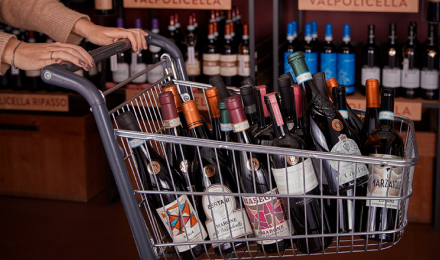- Red wines >
- Wines
Italy’s best red wines
All of Italy’s regions produce big labels, but there are some that have become iconic across the world. Tuscany,Piedmont,Veneto, andLombardy are some of these wine-producing highlights, with important designations such as Brunello,Bolgheri,Barbaresco,Chianti,Barolo,Valpolicella,Amarone, and Sforzato. Many people are unaware that these wines, which come in different designations, are based on the same red grape variety. This is the case with Sangiovese grosso, which is used to produce Brunello, Rosso di Montalcino, Chianti, Chianti Classico, Vino Nobile di Montepulciano, and Morellino di Scansano – wines that are very different from each other.
Major red wine designations
This demonstrates how the concept of a wine’s terroir is so much more than its variety: it includes the soil, climatic area, exposure, training of the vines and the human touch. Nebbiolo is used in Piedmont to produce both Barolo, known as the “king of wines and the wine of kings”, and Barbaresco, Gattinara, and Ghemme, as well as various lesser known designations (such as Boca, Bramaterra, Langhe, Lessona, etc.). In Lombardy, Nebbiolo, which is called Chiavennasca there, is used to produce another great aged red wine, Sfursat, along with other important designations, like Valtellina Superiore Inferno, also in a Riserva version, Valtellina Superiore Maroggia, Sassella, Grumello, and Valgella.
Red wine production
The main difference between red and white wine production is the maceration of the skins in contact with the must. When the alcoholic fermentation of red grapes begins, the pomace is left in contact with the must so the skins can release important substances like pigments and anthocyanins. Depending on the grape variety and the producer’s choices, the maceration can be brief (five to six days) to achieve a young red wine with vibrant colours and good drinkability. If maceration is extended (to 20 days or more), the red wine takes on a deeper colour, aromatic substances, and polyphenols, which give the wine more structure and ageing potential. After alcoholic fermentation, there is almost always malolactic fermentation, which makes the wine softer. Red wine can be aged in steel only, to maintain the variety’s typical organoleptic properties, or it can be rested in wood, whether large or small, to enrich the product with a more complex taste and aroma.
Pairings with reds
There is red and then there is red, as well as a few myths to debunk. The best red wines certainly pair well with meat thanks to their structure and the presence of tannin, but they can also accompany fish-based dishes if you follow certain sensible guidelines. With a rich fish soup with a strong flavour, you could pair quite a young Pinot Noir, while with salted cod you could try a Lacrima di Morro d’Alba. With simple dishes based on chicken, veal or beef, meanwhile, it is better to opt for slightly full-bodied red wines like Bardolino, Montepulciano d’Abruzzo, or wines with a bit more body like Rosso di Montalcino. With more elaborate dishes, such as roast pork and lamb or strong cheeses, the best option is full-bodied aged wines like Amarone, Barolo, and Cabernet Sauvignon. Generally speaking, if you are unsure, a regional pairing can save the day: braised wild boar calls for a Brunello, deer with a cranberry compote pairs very well with Lagrein, while lasagne with Bolognese sauce could be ideal with a lively Lambrusco.






































